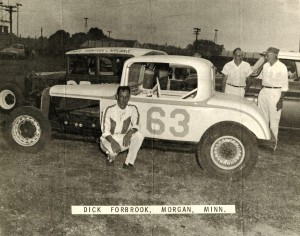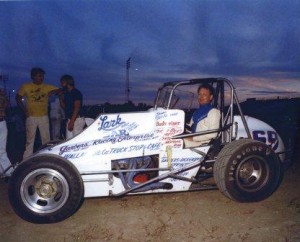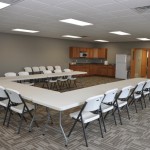https://soundcloud.com/maxyieldcoopmedia/dick-forbrook-2010-hall-of
Dick Forbrook’s first exposure to the sport of car racing happened in 1953 while in the military. Stationed near Atlanta, Georgia, he tagged along with a good friend who had a 1932 Ford with a flat head motor. It only took a couple of times behind the wheel of that ’32 Ford at Peach Bowl Raceway, and Forbrook was hooked on driving race cars.
Upon returning home from the service, he quickly struck out on his own racing career. He and several friends purchased a 1939 Ford coupe from a local gas station and began racing at 212 Speedway in Renville, MN. Like many first time racers, he found the difficult side of the sport as he crashed hard halfway through the season, essentially destroying the car.
Forbrook returned to racing the next year with a 1937 Ford coupe he built himself with an engine constructed by Loren Woodke. Racing three nights a week at tracks in Renville, Montevideo, and Atwater, Minnesota, the combination proved to be a formidable one. He achieved his first win in 1957, posting the victory in a trophy dash.
 He started to make his mark in the sport in the 1960’s. Forbrook raced modifieds extensively at Jackson Speedway from 1961-1968, and frequented Fairmont Raceway and many other Iowa and Minnesota speed plants.
He started to make his mark in the sport in the 1960’s. Forbrook raced modifieds extensively at Jackson Speedway from 1961-1968, and frequented Fairmont Raceway and many other Iowa and Minnesota speed plants.
He recorded many highlights in the modifieds. In 1963 he finished second in points at Jackson Speedway. In 1964, the Jackson modified drivers were invited to Algona’s race track to compete head-to-head. Behind the wheel of Ed Kennedy’s mod, Forbrook turned back all competitors, posting the convincing win against the Algona favorites, including Stacy Redmond and many other hot shoes. This win took a bit of creativity as the Jackson cars were allowed three carburetors, while the Algona mods were limited to two. Forbrook’s team unhooked the middle carb and went out and dominated the event.
He was crowned the 1964 modified champion at Jackson Speedway and the high point of 1964 included winning the season ender at the Clay County Fair in Spencer, Iowa, ahead of Sonny Morgan. This win started an improbable run of three victories in a row at the biggest modified show of the season. Racing against fields of 80 plus drivers, he was the Clay County Fair race winner in 1964, 1965, and 1966.
After amassing many modified wins, at the conclusion of the ’68 season, Algona, Iowa based sprint car owners Jim and Helen Utt asked Forbrook to driver their car. After becoming friends over the year’s with the Utt family, it was an easy decision for Forbrook to make and he quickly agreed to pilot the sprinter in 1969.
Forbrook’s first race for the Utt’s was at the famed Knoxville, Iowa speed plant and he reports he was scared to death before the race. Being unfamiliar with the car, Forbrook set the car up similar to his modified. The pre-race nervousness quickly subsided as he time trialed in third place. At the drop of the green flag, he quickly found the front of his heat race, but had to pull off due to exhaust header problems. He placed second in the dash behind Jerry Blundy and won the B-feature in order to qualify for his first main at Knoxville. After starting last, he raced to the top ten in the main event before the exhaust header problems resurfaced, forcing Forbrook to the pits.
This started a long sprint car career that saw Forbrook race across the country. At that time, many sprint car teams started their racing season in Tampa during the Florida State Fair and Utt’s team was no different. After racing in Tampa, and often racing to a top 10 in points at the conclusion of the Florida based events, they spent their summers chasing races in Iowa, Minnesota and the IMCA fair circuit.
 Through his sprint car career, there were notable memories. He was an IMCA sprint car event winner at the Clay County Fair in Spencer and the IMCA sprint car fair race winner in Hutchinson, Minnesota. While racing for the Utt’s he was crowned the 1975 sprint car points champion at Algona Raceway.
Through his sprint car career, there were notable memories. He was an IMCA sprint car event winner at the Clay County Fair in Spencer and the IMCA sprint car fair race winner in Hutchinson, Minnesota. While racing for the Utt’s he was crowned the 1975 sprint car points champion at Algona Raceway.
In addition to many feature wins in his career, he finished third to Steve Kinser and Doug Wolfgang at Lincoln, Nebraska on the first night of an Outlaw show and finished second to Wolfgang the next.
He remembers one particular clean sweep at the Jackson half mile. In those days, you went to victory lane for a presentation after every race you won. After winning his heat race, Forbrook posed next to the trophy girl, the reining Miss Minnesota. Forbrook promptly leaned over and gave her a kiss. He then returned to victory lane following his trophy dash win. This time he received no kiss after the trophy queen stated ‘kissing you is not in my contract’. After winning the night’s main event, the first thing she said was ‘are you the only one who wins around here?’
Like any racer there were some races that got away for Forbrook. He was leading the Iowa State Fair sprint race for the Utt family when he suffered a flat tire. With the Utt’s they ran on the asphalt at the Minnesota State Fair four times, once with the modified and three times with the sprinter. One year he was leading by a half lap when he ran out of fuel.
His best shot at a Jackson Nationals win occurred in 1980. After failing to qualify due to motor trouble, Forbrook raced up from the back of the pack to win the C-main in the Garber-Nance no. 69. He lined up in the B-main in 21st, but clawed his way to fifth to earn a spot in the championship feature. In the A-main, he lined up deep in the field and raced up to the fourth spot. His run to front ended before the checkers fell as motor problems forced Forbrook to the pits.
Forbrook took one stint behind the wheel of a full bodied late model stock car. Over the course of a busy Memorial Day weekend, he competed in six events over three days. They raced on a Saturday afternoon in Lincoln, Nebraska with the Utt sprint car and then headed down I-80 to compete at the Iowa State Fair in the late model that night. Forbrook returned to Lincoln on Sunday to race the sprint car and then raced that night in Harlan in the late model. On Monday’s Memorial Day holiday it was back to Lincoln to finish the sprint car triple header. That night he capped off the amazing weekend run by completing the 100 lap late model show in Omaha. By the end of the final event, Forbrook had to be carried out of the car due to exhaustion.
Forbrook’s last year behind the wheel was in 1985 at the controls of Harry Torgeson’s sprinter. He raced the South Dakota based car to second in points at the Hartford, South Dakota speedway.
 Though he was retired from driving, Forbrook spent a lot of time helping his son Guy with his racing career. Guy followed in his father’s footsteps, becoming a successful driver in his own right. Dick recalls one summer early in Guy’s career that his son blew the last motor in the stable. While it looked like they might be done, Dick offered up a solution. After placing Dick’s 301 cubic inch motor between the frame rails (and twisting the heck out of it according to Dick), Guy went on to win his next six events.
Though he was retired from driving, Forbrook spent a lot of time helping his son Guy with his racing career. Guy followed in his father’s footsteps, becoming a successful driver in his own right. Dick recalls one summer early in Guy’s career that his son blew the last motor in the stable. While it looked like they might be done, Dick offered up a solution. After placing Dick’s 301 cubic inch motor between the frame rails (and twisting the heck out of it according to Dick), Guy went on to win his next six events.
Forbrook was also a familiar face in his son’s pit after Guy successfully transitioned to a full-time sprint car owner. Together, they crossed the country, competing in the biggest races sprint car racing had to offer.
Forbrook’s competitive spirit helped him accomplish success in about every sport he’s attempted. As a high school football player, his team lost only two games in four years. He also won the 1978 World Series Snowmobile championship at Eagle River, Wisconsin.
In 1997, Forbrook was inducted into the Knoxville Raceway Hall of Fame. He was inducted into the Jackson Speedway Hall of Fame in 2004.
He and his wife Jeri celebrated their 50th wedding anniversary in March 2010. They reside in Morgan, Minnesota, operating Dick’s Sport Center, a power sports dealership they have owned since 1972. They spend much of their free time with family and helping their grandchildren with their fledgling go cart racing careers. Grandson Brady Forbrook won the go cart championship at their home track in 2009.



